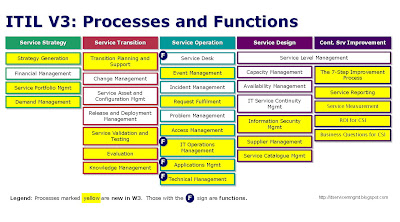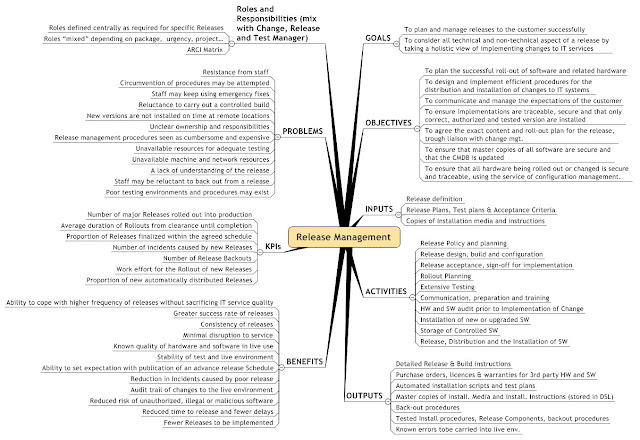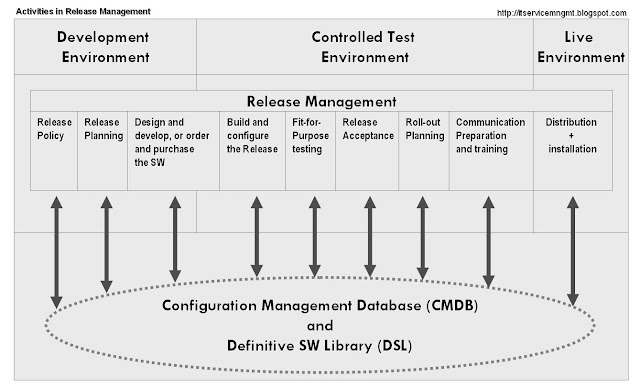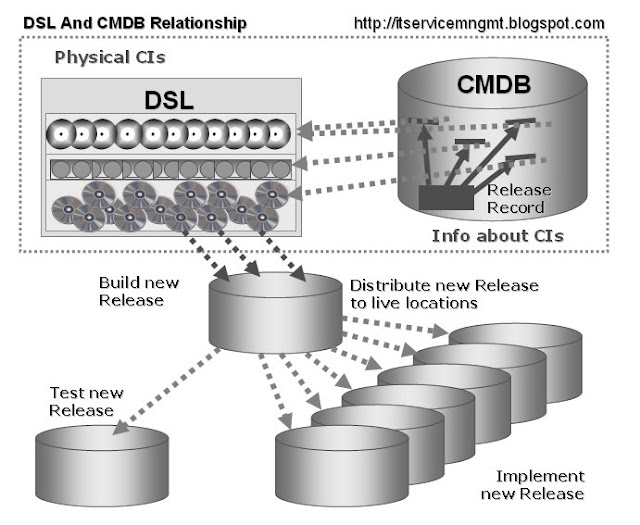The Ever-Changing Scheme Of Things
So there is an almost complete ITIL V3 Qualification Scheme for the people!
The scheme is comprised of five distinct levels. Every completed level or module earns specific amount of credit points, and upper levels sometimes have prerequisite of minimum credit points from the previous levels or bridged V2 levels.
For now, all of the exams are supervised, closed book exams. Candidates approaching the exam in their non-native language usually get 20-30% bonus time from the original defined duration.

1. Foundation
ITIL Foundation is an entry level introductory course. It is targeted to IT professionals who need understanding of basic ITIL skills and comprehension/awareness of the following:
- Service Management as a practice (Comprehension)
- Service Lifecycle (Comprehension)
- Key Principles and Models (Comprehension)
- Generic Concepts (Awareness)
- Selected Processes (Awareness)
- Selected Roles (Awareness)
- Selected Functions (Awareness)
- Technology and Architecture (Awareness)
- ITIL Qualification Scheme (Awareness)
Exam duration is 60 min (75 min non-native + allowed dictionary), 40 multiple choice questions, with only one answer per question correct. False answers are not penalised.
There are online and paper based versions.
Pass Score is 65% (26 correct answers). No distinction level.
I have seen the course material and mock-questions. I have also seen some real exams. In some cases these two are very loosely related. My opinion from the previous post did not change much. If I hear anything new, I will let you know here.
2. Intermediate Level
This level kind of inherits the former practitioners course. It is divided in two modular streams, Lifecycle and Capability stream. Lifecycle stream is for people who need understanding of Service Lifecycle concept and its stages. Capability stream is oriented towards process/functions/roles type of IT Professionals.
2.a Lifecycle Modules
Five standard lifecycle modules - Service Strategy, Service Design, Service Transition, Service Operation, Continual Service Improvement.
Each completed module earns 3 credits.
Prerequisites are a Foundation certificate and 21h of accredited classroom module course.
Recommended 21h of personal study.
Exam duration is 90 min (120 min non-native speakers + allowed dictionary), complex multiple choice, multi-part scenario based. One answer is most correct and earns maximum points. Two other options are consecutively less correct, marked slightly less then the correct answer. One option is incorrect and earns no marks. This is called Gradient Scoring.
Pass score is 65%, distinction score is 75%.
2.b Capability Modules
Four modules representing functional clusters:
- Planning, Protection and Optimization (Availability Management, Capacity Management, IT Service Continuity Management, Demand Management, Risk Management, Information Security Management)
- Service Offerings and Agreements (Service Portfolio Management, Service Level Management, Service Catalogue Management, Demand Management, Supplier Management, Financial Management)
- Release, Control and Validation (Change Management, Service Release and Deployment Management, Service Validation and Testing, Service Asset and Configuration Management, Knowledge Management, Request Fulfillment, Service Evaluation)
- Operational Support and Analysis (Event Management, Incident Management, Request Fulfillment, Problem Management, Access Management, Service Desk, Technical Management, IT Operations Management, Application Management)
Prerequisites are a Foundation certificate and 30h of accredited classroom module course. Recommended 12h of personal study.
Exam duration is 90 min (120 min non-native speakers + allowed dictionary), complex multiple choice, multi-part scenario based. Grading method is Gradient Scoring, the same as in Lifecycle stream.
Pass score is 65%, distinction score is 75%.
Exams can be online or paper based.
Capability stream is more to my liking, looks like sleeve-roll up stream for the guys in the trenches.
You can choose modules which are aligned with your current or intended job position, no defined order here. Logical to me would be to take one or two Lifecycle modules (Operation & Transition) and then a few practical Capability modules.
Earn 17 credits, and you can proceed to
3. Managing Across the Lifecycle
This title is a bit pompous and clumsy at the same time. Like some other things in V3, it looks like it was worked out in haste. Never mind. This course is meant for managers, and includes "ancillary" (this English kills me sometimes :-D) knowledge:
- Introduction to IT Service Management
- Business & Managerial Issues
- Managing the Planning and Implementation of IT Service Management
- Management of Strategic Change
- Risk Management
- Managerial Functions
- Understanding Organizational Challenges
- Lifecycle Project Assessment
- Understanding Complementary Industry Guidance
Prerequisites are a Foundation certificate and 30h of accredited course (classroom based or e-learning). Recommended 28h of personal study.
Exam duration is 90 min (120 min non-native speakers + allowed dictionary), complex multiple choice, multi-part scenario based. Grading method is Gradient Scoring.
Pass score is 65%, distinction score is 75%.
Exams can be online or paper based.
4. ITIL Service Management Expert Certification
By accumulating a minimum of 22 credits in the previous modules, one is entitled to this certificate. You get 2 credits from Foundation and 5 from mandatory Managing Across the Lifecycle. The other 15 you can collect from collecting Lifecycle and Capability modules credits. OGC says something about a balanced approach, which boils down to minimum two modules from each stream. Have a look at the Figure 3 table in the original document.
The other way to achieve ITIL Service Management Expert Certificate is to arrive from ITIL V1 or V2 Managers Certificate (17 credits) and obtain a V3 Managers Bridge (5 credits) certificate.

Bridging
I choose not to go deeper into the bridging subject, since it's basics are obvious from the Picture 2, and it is well covered in the OGC/APMG original document. There is only one case which is benig discussed on http://itsmfi-forum.org/view_topic.php?id=5&forum_id=12&jump_to=323#p323 that still needs some clarification: what will a V2 Practitioner do if he/she didn't collect 12 credits. When it becomes clear, I will update this post.
Here is a short summary table with exam-specific parameters:

Best of luck to anyone sitting an ITIL exam anywhere on the globe!
And of course, the complete Official Scheme PDF document with much more details can be viewed at http://www.best-management-practice.com/gempdf/ITILV3_Qual_Scheme_v3_0.pdf
Additionally, have a look at available syllabi at ITIL-OfficialSite:
- ITIL V3 Foundation Certificate Syllabus
- ITIL V3 Foundation Bridging Course Syllabus
- ITIL V3 Managers Bridge Course Syllabus
Update September 08 - Syllabi for the Intermediate Level:
Capability Stream
- Operational Support and Analysis Certificate Syllabus
- Planning, Protection and Optimization Certificate Syllabus
- Release, Control and Validation Certificate Syllabus
- Service Offerings and Agreements Certificate Syllabus
- Service Strategy Certificate Syllabus
- Service Design Certificate Syllabus
- Service Transition Certificate Syllabus
- Service Operation Certificate Syllabus
- Continual Service Improvement Certificate Syllabus
- Managing Across the Lifecycle





















